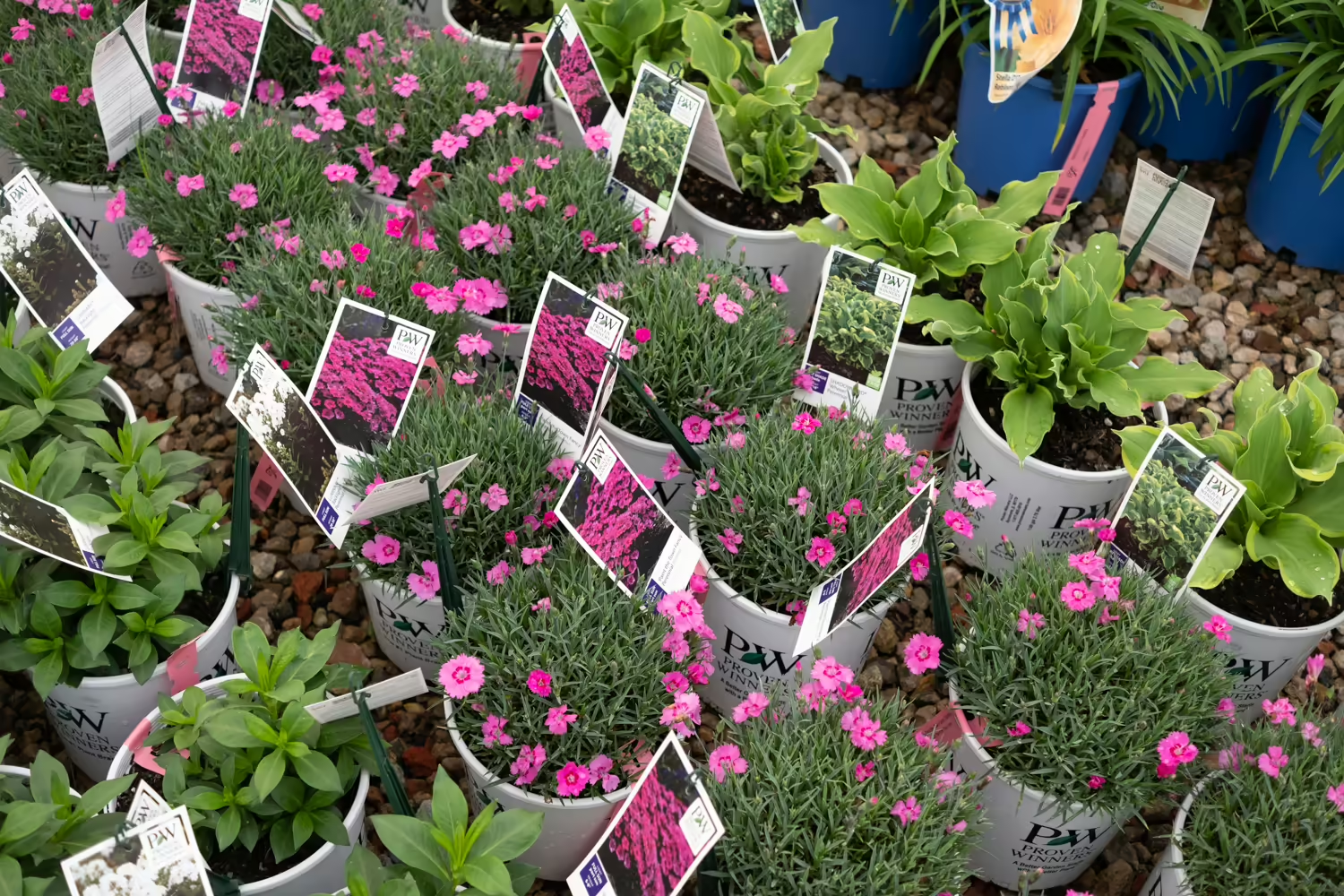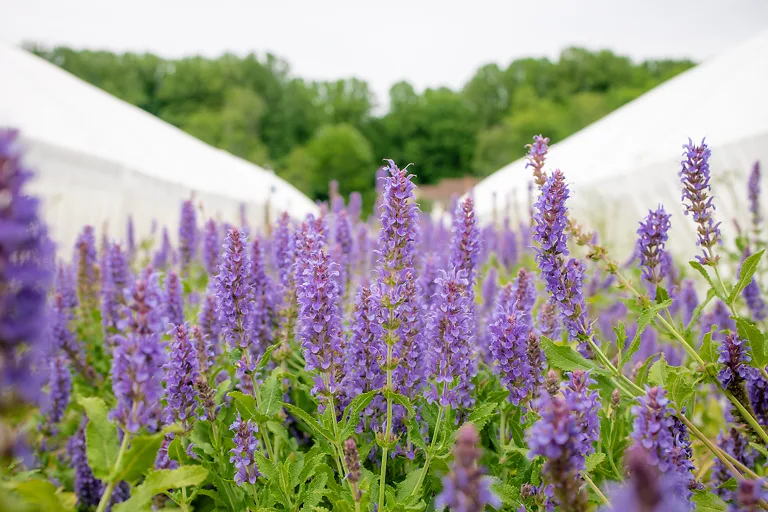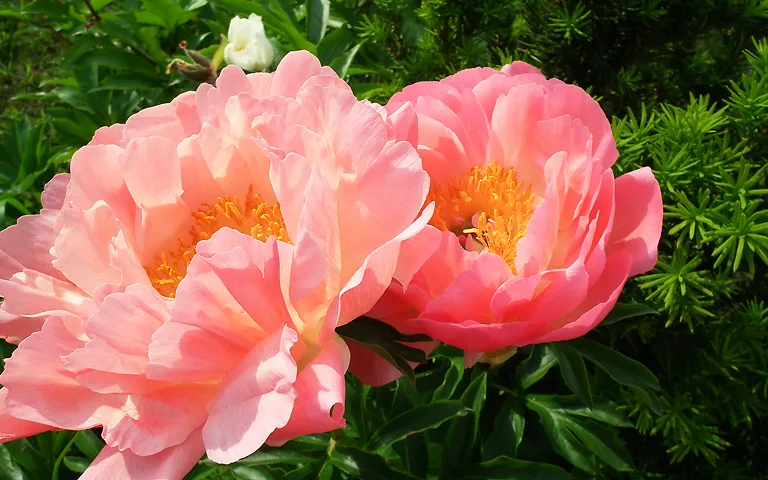
Written by s • Garden Pinks for American Gardens
Spring is always full of beauty, and as it draws to a close, and summer approaches, we see the blooming of one of the most beautiful groups of plants – garden pinks. These plants, some hybrids and some selections of wild species, all belong in the plant genus Dianthus, and the names are used interchangeable, or sometimes they are all simply called ‘pinks’. While loved by almost everyone, these plants originated in Europe, especially England, where climates are very different. So growing them can be a challenge outside of the northeast. That is changing, though, as American breeders use the best of Europe to create new Garden Pinks for American Gardens.
What are Garden Pinks?
Dianthus mostly come from the mountains of Europe, although one comes from Arctic North America. There are well over 300 species, and collectors of alpine plants may grow large numbers of them. They are all remarkably similar, with flowers that have 5 flat petals forming a circle, usually with fringed or ‘pinked’ edges, and often with a darker colored circle or zone in the center, creating what is called an ‘eye’. For many people the most well known Dianthus would be the carnation, but for gardeners these are not really suitable plants. They are tall, need support, and grow best in a greenhouse or mild region. They have always been cultivated commercially for florists, and their fascinating development is a story for another time. It is the smaller types, growing from mats of foliage on the ground, which are much more suitable for gardens, and it’s these we will talk about here.
It seems to be accepted that the name ‘pink’ comes from the serrated edges of the petals, which resemble the cuts made by those special scissors used by dressmakers to make those angled cuts called ‘pinking’. That in turn comes from an ancient word meaning to pierce or puncture, connected by the serrated shape of spurs used for horses. It is amazing that this word then became the color as well – language flows like water.
Pinks have been in Gardens for a Long time
Pinks have always been highly-esteemed – even the name comes from Dios (God) and Anthos (flower). The strong clove scent of many made them popular for ‘nosegays’ – clusters of perfumed flowers carried to use when passing through smelly neighborhoods, which were all too common before sewage systems and garbage collection (or regular bathing!). they were also used to flavor wine, adding the spicy flavor of cloves, and there were even special varieties just for this, mainly the white flower still called ‘Sops in Wine’. In the 19th century there was a lot of interest in plants, and ordinary working men developed hobbies, like breeding a certain kind of plant. Dianthus were popular because they were small plants that could be grown in pots and raised easily from seeds. Many elaborate and beautiful flowers were created, mostly from plants that originated as hybrids between the carnation, Dianthus caryophyllus and a wild species, Dianthus plumarius, variously called wild pink, clove pink or just garden pink.
Modern Breeding of Garden Pinks
The English have a special love of garden pinks, and one of the top breeders of recent decades was John Whetman. His nursery, Whetman Pinks, is renowned around the world for the creation of new varieties. Nestling on the south coast of Devon, the nursery began as a cider orchard, and after Word War II shifted to growing cut flowers to send by train to the Covent Garden flower market in London. There were few varieties available, and the most popular was a plant called ‘Doris’.
In the 1980s there was a revival of interest in garden perennials, and a demand for new cut flowers, so Whetman set up a facility for breeding new varieties to satisfy this demand. It takes an average of 7 years from the first cross to the first commercial crop, so new varieties take time to appear.
Whetman export around the world, including to the United States, and varieties from other countries also come to America. But our climate is difficult, with colder winter and hotter summers too, compared to the gentle British weather. How to bring the exciting results of breeding such as Whetman’s to American gardens?
Adapting Pinks to American Gardens
Sometimes it turns out that a British plant will grow just fine in warmer parts of America, and that is how we have the beautiful range of Dianthus called the American Pie™ Collection. Coming from the skilled hands of John Whetman, they have been trialed under American conditions and passed with flying colors. One of the most popular is Georgia Peach Pie (‘WP15 PIE45’), which has abundant flowers a full 1½ inches across on a foot-tall plant. Like all the best modern varieties, it doesn’t just bloom in spring, but continues through summer into fall.
Another solution is to use these plants for further breeding, rather than simply try to grow them here. That is what Walters Gardens Inc. is doing. At their nursery in Zeeland Michigan Hans Hansen, their head breeder, has been working on pinks, using plants from Whetman, and also from other international breeders, such as in Japan. [In Japan these plants are given on Mother’s Day, creating a large market for them.] How to make these plants grow better across America? The solution is to ‘borrow’ genes, through breeding, from other species of Dianthus that grow better in the American climate.
Tough Pinks
For tougher plants the place to look is among the low, mat-forming wild species. Although these often come from mountain areas, with cool weather, some have proved to be much tougher in the American climate.
The most promising is Dianthus gratianopolitanus, the clove pink or Cheddar Pink. ‘Clove’ for its fragrant blooms, and ‘Cheddar’ because it grows at the famous Cheddar Gorge in England. Low-growing, with small, single flowers, but produced in abundance, the silver-blue foliage is a great accent too. These plants have proven themselves reliable in the southeast, where most other species fail. One popular variety is Firewitch (‘Feuerhexe’), shown here.
Hans Hansen crossed one of John Whetman’s plants called ‘Neon Star’ with a variety of Cheddar pink from Japan called ‘Holkahori’ (Kahori®). This gave him many seedlings that mixed the genes of the tough Cheddar pink with the beauty and larger flowers of the garden pink. To get even more diversity he crossed some of these seedlings together. From this material he is developing a range of plants called ‘Paint the Town. . .’ Already there are four – ‘PtT Fancy’, ‘PtT Fuchsia’, ‘PtT Red’ and ‘PtT Magenta’, and we hope more are to follow. Great plants for fronting beds and growing in rock gardens, and both reblooming and able to thrive in the southeast.
If you like your garden pinks with fluffy double flowers, then there are new varieties for you, that are also great in our gardens. Check out the Fruit Punch® range that Hans Hansen has created.
These plants are hybrids from Whetman varieties, which have then been tested and selected for American growing conditions. They have good resistance to the ‘center die-out’ disordered that is the biggest problem in the southeast. Big enough to cut for a vase, and cute and colorful for a real old-fashioned garden look, we hope that this is only the beginning of a new generation of garden pinks for American gardens.







